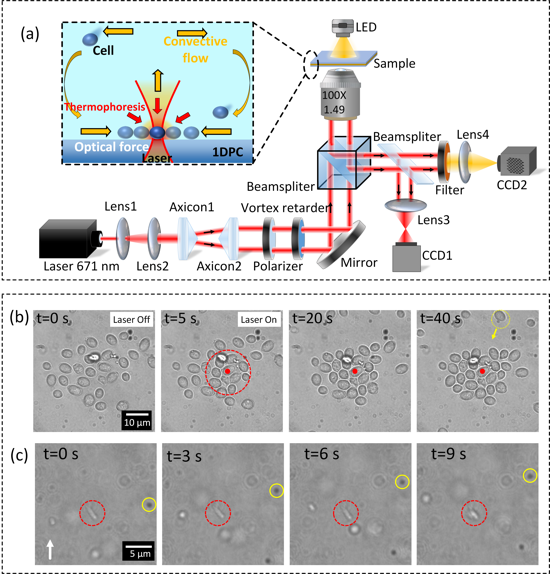Optical tweezers (OTs) provide a powerful tool for trapping, guiding, and assembly of biological nanoparticles and cells, thus playing a unique role in biomedical and photonics areas. Particularly, OTs have been widely used to explore the structure, mechanism, and interaction of cells due to their ability of non-contact and high-resolution manipulation.
However, conventional optical tweezers trap tiny objects using optical gradient forces near a tightly focused laser beam, which have a limitation in long-range transportation and manipulation of target objects, and cannot manipulate lots of biological objects. To confront these challenges, various types of external fields have been applied for novel tweezers to achieve dynamic manipulation and long-range delivery of target objects. For examples, opto-thermal tweezer, opto-thermoelectric tweezers, and electrothermoplasmonic tweezers, have emerged and demonstrated their potentials in cell studies over conventional OTs.
Recently, Prof. Douguo Zhang and Dr. Lei Gong from University of Science and Technology of China (USTC) propose a novel technique for controllable optofluidic assembly of biological cells using an all-dielectric one-dimensional photonic crystal (1DPC) platform. The technique takes the advantages of both conventional optical tweezers and thermophoretic manipulation simultaneously. Stable trapping of single particle by the optical gradient force and reversible assembly of many biological cells are achieved by such an opto-thermophoretic tweezer. This work has been published in Photonics Research Vol 10, No. 1, 2022 (Fengya Lu, Lei Gong, Yan Kuai, Xi Tang, Yifeng Xiang, Pei Wang, Douguo Zhang. Controllable optofluidic assembly of biological cells using an all-dielectric one-dimensional photonic crystal[J]. Photonics Research, 2022, 10(1): 01000014).
Different from the metallic substrates used in conventional opto-thermophoretic tweezers, the all-dielectric 1DPC platform is used in this work. The 1DPC is an all-dielectric multilayer film with a photonic band gap, where Bloch surface waves (BSWs) can be sustained on the top-surface of the multilayer. Figure 1(a) shows the schematic diagram of the experimental setup. BSWs feature localized electric field enhancement and will induce local heat source on the multilayer due to the intrinsic loss of the multilayer (especially the Si3N4 layer).

Figure 1 Schematic diagram of the experimental setup and manipulation of biological cells.
Thus, a stable-state temperature gradient field forms on the multilayer. Remarkably, compared with metallic substrates, the 1DPC substrate can achieve lower temperatures but comparable temperature gradients due to the low thermal conductivity, which is beneficial for low-power optofluidic manipulation.
The 1DPC-based tweezer enables the combination of the long-ranged flow-induced force, local thermophoresis force and short-ranged optical force that is associated with focused BSWs. By exploiting the capacity of both optical and thermophoretic manipulation, controllable assembly of many yeast cells as well as E. coli cells have been demonstrated, as shown in Fig. 1(b) and (c).
In addition, numerical simulations were performed to calculate the temperature distribution and convective flow velocity, which are consistent with the experimental observations and then further justify the feasibility of the proposed method. The optofluidic manipulation with the all-dielectric 1DPC platform opens a new way for long-range transportation, sorting, and self-assembly of biological cells, promoting potential applications in biomedical sciences. With an optimized design, such a platform is expected to benefit functional micro opto-fluidic chips. Furthermore, this work also provides new insights in the potential of optical films as special devices.
Ph.D candidate Fengya Lu is the first author, Prof. Douguo Zhang and Dr. Lei Gong are the co-corresponding authors. This work was supported by The National Nature Science Foundation of China, Advanced Laser Technology Laboratory of Anhui Province, Hefei Municipal Natural Science Foundation, as well as Key Research & Development program of Anhui Province. The work was partially carried out at the USTC Center for Micro and Nanoscale Research and Fabrication. D.G.Z is supported by a USTC Tang Scholarship.


